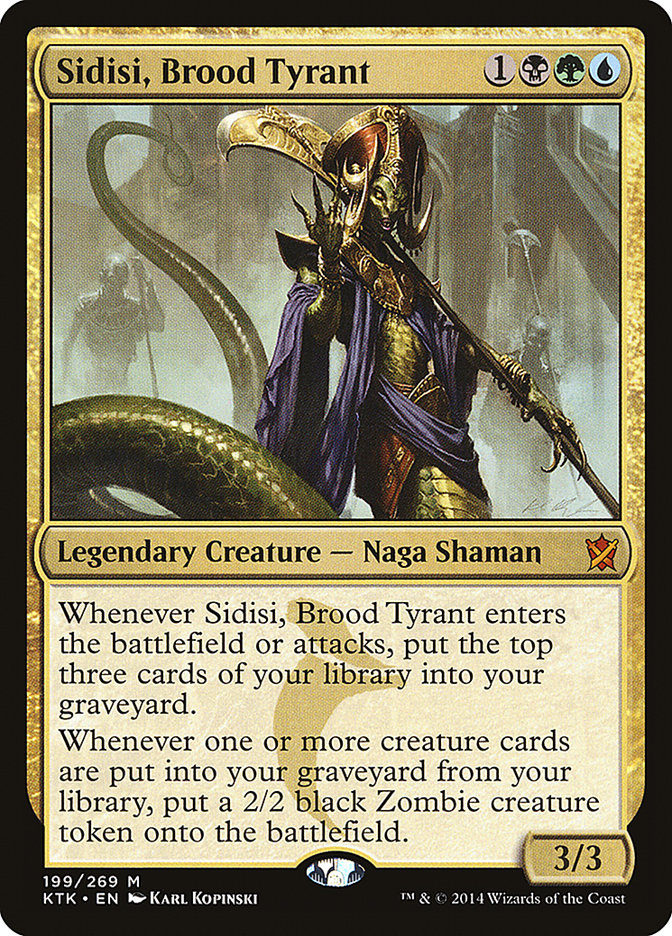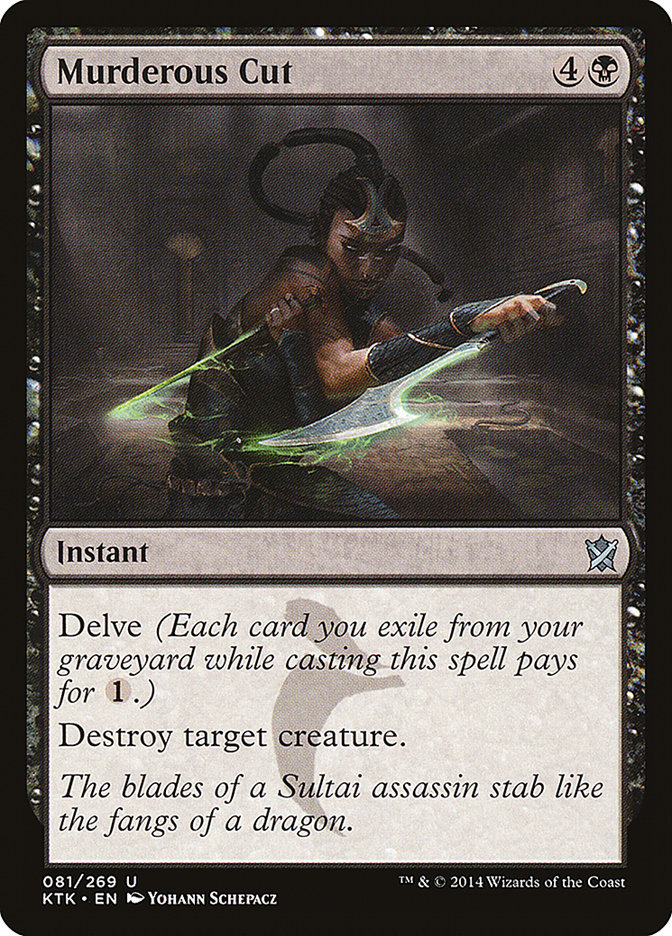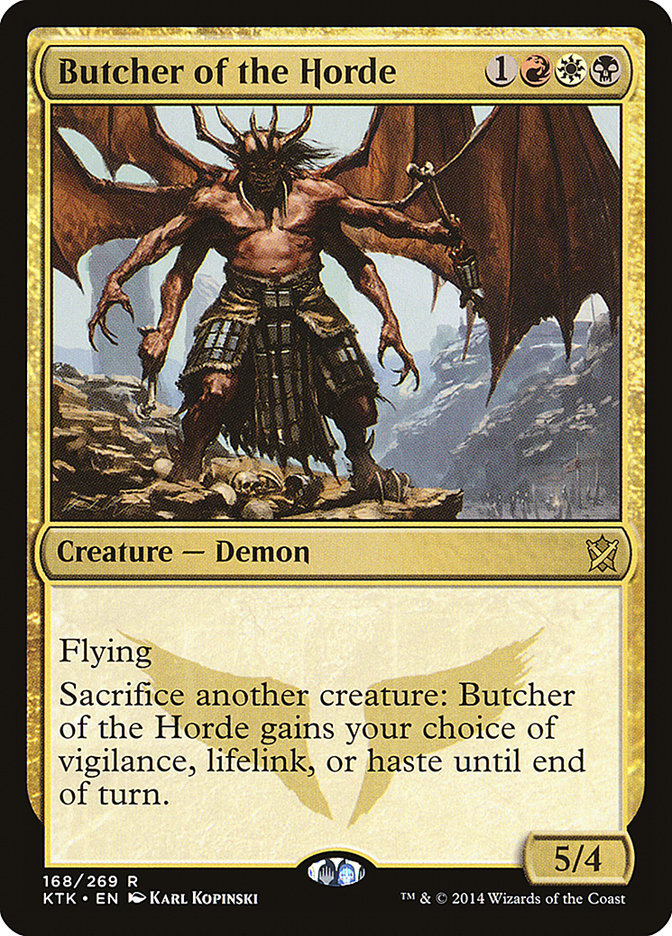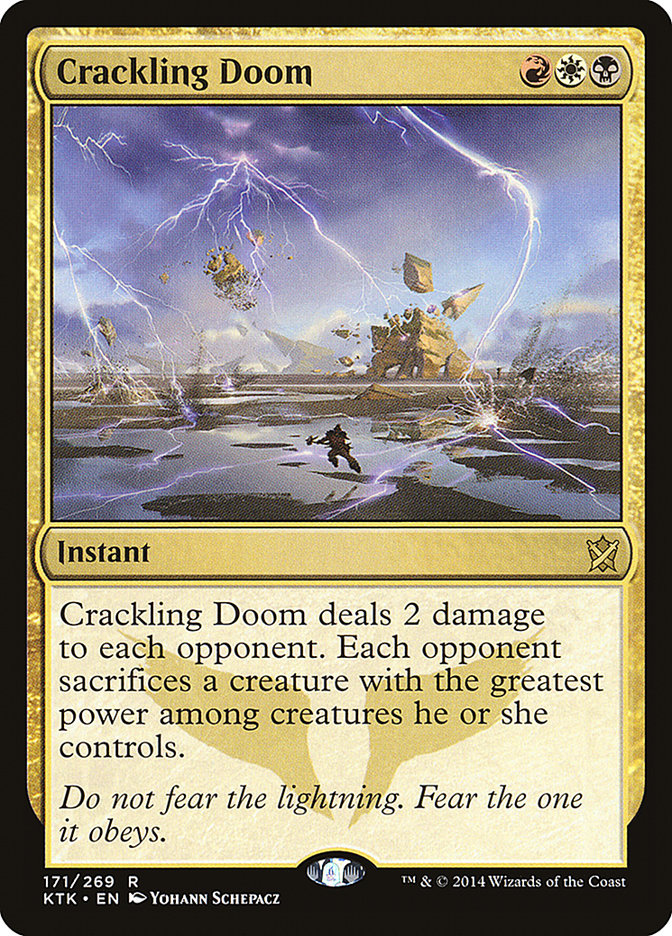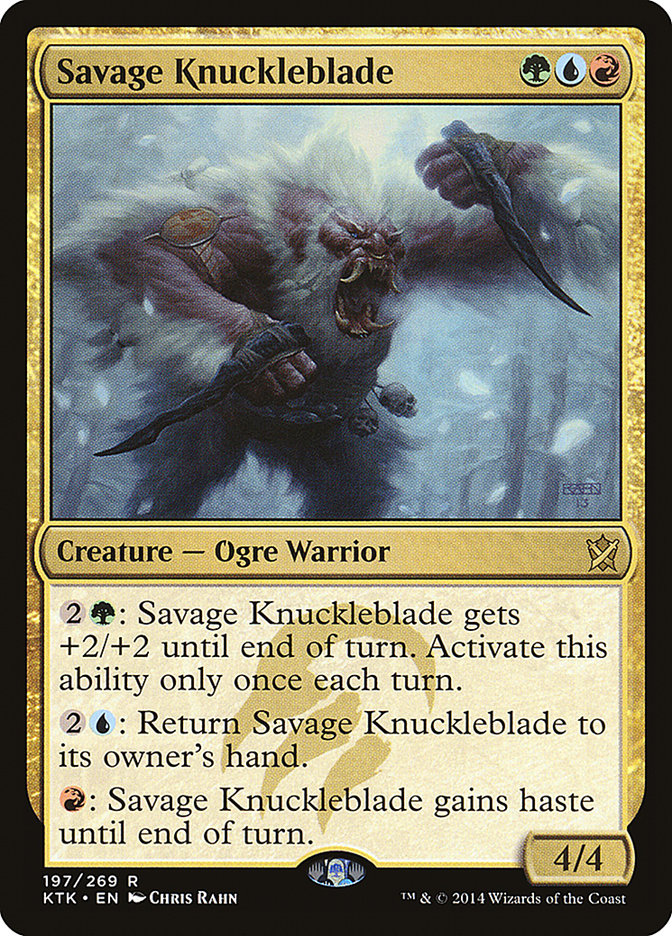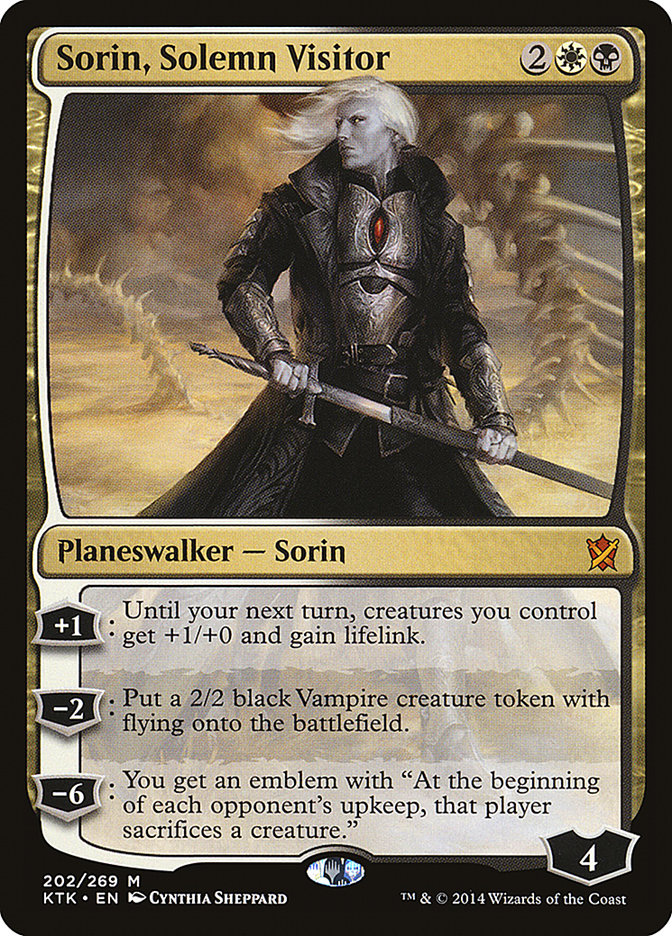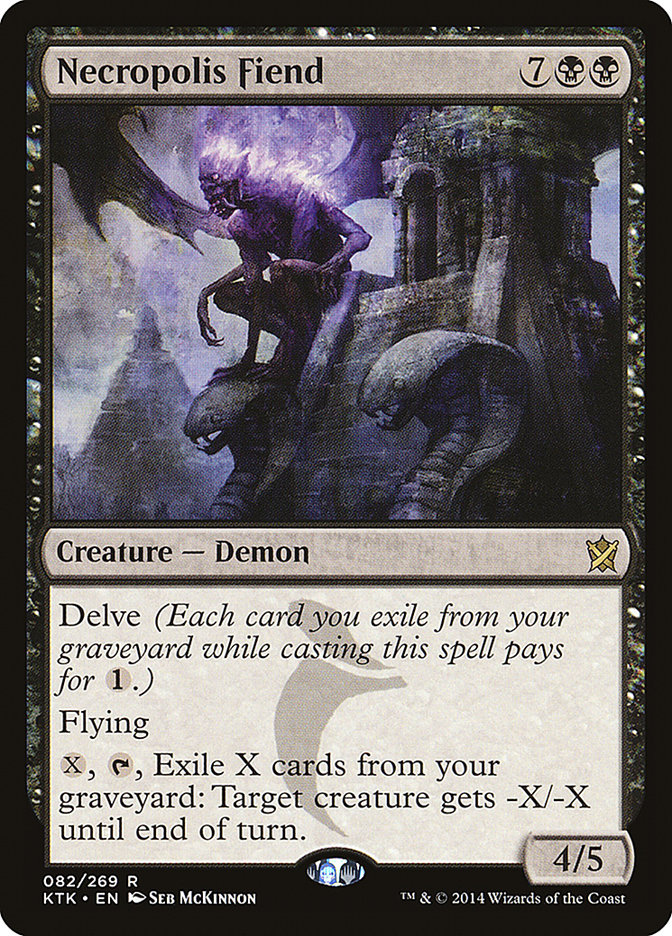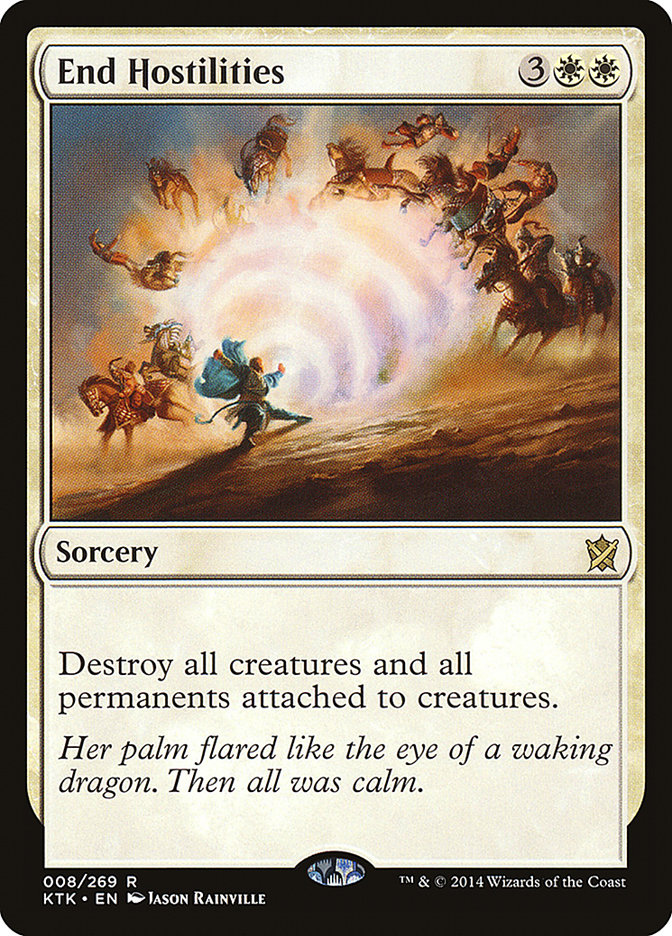One side effect of having the job I have is that I get to play a variety of different cards and different decks by virtue of having the Versus Video
series. It can definitely be a blessing and a curse. When it comes to lame duck Standard formats like the one we’re about to leave–a Standard format that
has seen almost no change since Theros was released a year ago–it is definitely a curse. It can grow tiring bashing your head against the same Mono-Black
and Mono-Blue Devotion wall over and over again. I wasted so many hours trying to brew decks in that format to no avail. I couldn’t break free from the
rock that was Mono-Black on one side and the hard place of Mono-Blue on the other.
When it comes to new formats though, it’s all upside. Recording a lot of videos challenges me as a deckbuilder to constantly come up with new ideas or
explore old ones in the context of new cards. When I look at a set like Khans of Tarkir, I see a lot of powerful cards, but realistically, there are only a
small handful of cards that catch my eye as something I actually care about brewing around. Doing the Versus Videos challenges me to think beyond that box
and come up with ideas for cards I wouldn’t normally touch.
As of the time I’m writing this article, I have recorded four Versus Videos with Khans of Tarkir. That’s four videos with four different decks against four
different archetypes. This means that I’ve started to get a feel for how games are going to play out in this format. It’s clear year after year that you
have to actually play with the cards to learn what is good or not. Simply looking at the spoiler isn’t going to tell the full story.
Remember Aurelia’s Fury? That card was extremely hyped and ended up being a bust. Similarly, Restoration Angel was a relatively under the radar card for
the first few months of legality. Things aren’t always as they seem and sometimes the most powerful cards take a while to discover. Sometimes the most
hyped cards end up being much weaker than they seemed. Sometimes Goblin Rabblemaster starts out at $1 before people realize how powerful the card really
is.
I’d like to talk a bit about some of the things I’ve learned from those videos and my predictions for what Khans of Tarkir Standard is going to look like.
Master or Commander
Quite simply, I am not that interested in playing a Standard deck that doesn’t have one of these two cards: Goblin Rabblemaster or the Commander card,
Hornet Queen. I feel like these are the two ends of the Courser/Caryatid format.
With Goblin Rabblemaster, your plan is to just simply overpower the Courser/Caryatid decks. While they are taking turns building their mana and getting set
up, you can just go ahead and kill them. I feel like Goblin Rabblemaster fits best into a shell with a lot of removal spells. You don’t actually need much
pressure beyond Rabblemaster to kill them. You just need to stick a Rabblemaster and then kill their first few blockers, and things start to spiral out of
control from there.
Hornet Queen just completely goes over the top of and trumps all of the other midrange Courser/Caryatid decks. They have a Dragon, Polukranos, and Savage
Knucklehead in play? Cool story. Here’s a Hornet Queen. Buzzzzzzzzzz. “Honey, what’s that buzzing sound? Is that the doorbell? Open it up and see who’s
there.”
It’s Hornet Queen. Should have locked the door.
The Too Slow Fallacy
One aspect of Khans of Tarkir is that, for the most part, all of the good cards cost like 3-4-5 mana. In fact, there is an enormous wealth of powerful
cards around this mana cost. All of these huge undercosted fatties like Savage Knucklesandwich, Anafenza, the Foremost, Siege Rhino, Butcher of the Horde,
Surrak Dragonclaw, and others are all in the 3-5 sweet spot.
Likewise, all of the good removal spells cost three or more, such as Banishing Light, Hero’s Downfall, all of the charms, Utter End, etc. Lightning Strike,
Magma Jet, and Bile Blight are the only strong removal options that you can actually play on turn 2. The issue is that exactly zero of those can kill a
Courser of Kruphix by themselves. Suspension Field can, but it has its own slew of drawbacks, such as enchantment removal and the situational nature of the
card.
One potential mistake in deckbuilding that I have made and that I have seen others make as well is simply not having enough early plays. It is extremely
easy to just build your deck such that Elvish Mystic, Sylvan Caryatid, Rattleclaw Mystic, or Voyaging Satyr are the only plays your deck can make in the
first few turns of the game. If you simply don’t have one of those in hand or your opponent Magma Sprays your Elvish Mystic, your deck becomes super
clunky.
It creates a weird dynamic where you don’t want to overload on situational cheap removal spells because they don’t actually kill a lot of the important
creatures in the format. However, you also don’t want to skip on them entirely, because then your deck becomes extremely clunky when you don’t have a
Sylvan Caryatid or Elvish Mystic in the opening hand and you become very vulnerable to just dying to an aggressive start before you can even develop a
board presence.
It’s going to be important to find solid two mana spells to complement these threat-dense Courser of Kruphix decks. Right now, Rakshasa Deathdealer is the
card that really pops out to me as a strong option. It’s a two drop that can attack through an opposing Courser, meaning it can retain relevance as the
game progresses. Satyr Wayfinder is another card that I really like a lot in this format. It’s a cheap play that fuels delve, ensures you hit land drops,
and can actually trade with the wealth of 2/1’s for 1 mana that exist in this format.
Soldier of the Pantheon, I’d like to introduce you to an old college buddy of mine, Satyr Wayfinder. Have you seen Firedrinker Satyr around?
Oh, and hey. While we’re on the topic of those 2/1’s for one…
One Drops Suck
I don’t mean to say that you can’t cast cards like Soldier of the Pantheon or Bloodsoaked Champion and be successful, but these cards simply aren’t going
to cut it on their own merits. You can’t just play a bunch of hyper aggressive creatures and expect to get there. All it takes is a single Courser of
Kruphix, Savage BrassKnuckler, or Anafenza, the Foremost and your hard work just went down the drain, especially if you’re relying on those cards like
Lightning Strike or Magma Jet to get the job done. Stoke the Flames is a sweet one, but that still doesn’t punch through Sylvan Doesn’t Care-yatid and
PolukraNope, World Eater.
In the last format, cards like Rubblebelt Maaka, Titan Strength, and Ghor-Clan Rampager punished blocking 2/1s with your Courser of Kruphix. In this
format, if you’re playing 2/1’s for one, you have to have a similar way to punch through their Courser. Titan’s Strength doesn’t quite get the job done
because your creature is still going to trade.
One option is to let cards like Mogis’s Warhound and other bestow creatures make a triumphant return. Turning your 2/1 into a 4/3 is exactly the perfect
size to ensure that their Courser of Kruphix stays on do-nothing duty. Cards like Spear of Heliod or Dictate of Heliod might be necessary in these kinds of
decks to let you punch through later in the game. All I know is that you can’t just play Lightning Strikes and one drops by themselves. You need to have
some way to pump them past Sylvan Caryatid and Courser of Kruphix.
Another option is to play a bunch of removal spells like Hero’s Downfall, Banishing Light, Suspension Field, or Murderous Cut to try to clear the way for
your one-drops. Personally, I feel like that this isn’t a great plan. Eventually, they will stick a fat creature you don’t have a removal spell for (or
don’t have the right removal spell), or stick a Sylvan Caryatid that has hexproof. At that point in time, all you’ve really done is spend a bunch of mana
killing their creatures and attacking for ten damage with your one drop. They might be at like eight life, but it is easy for those decks to stabilize and
take over and finish a game very quickly.
The last option is to avoid most one drops altogether. In 2013, Thragtusk ruled the roost. Zombie decks had to adopt a much bigger gameplan, where they
only played the most powerful one and two drops like Gravecrawler and instead focused on big creatures like Hellrider and Thundermaw Hellkite to just power
through and go over the top of Thragtusk. Trying to kill them with hyper aggressive one and two drops was a strategy that was doomed to lose to Thragtusk.
I feel like we may be facing a similar situation. It’s hard for a hyper aggressive deck to punch through Courser of Kruphix, Sylvan Caryatid, and
Polukranos (or Siege Rhino, or other fatties). I feel like aggressive decks are going to play the one drops that can still attack through Caryatid
(Firedrinker Satyr) and then focus on just going bigger with cards like Rabblemaster, Butcher of the Horde, and a fat finisher like Zurgo Helmsmasher,
Sarkhan, the Dragonspeaker, or Stormbreath Dragon.
Now that I’ve spoken a bit about some of the strategies that I think will and won’t work in the format, I’d like to actually look at some of the cards
themselves.
This card is pretty good. One neat thing that I hadn’t really thought about with this card, but that is actually just a beating is that if you combine
Sidisi with removal spells, you can just tempo your opponent out of the game. It works much the same way as Goblin Rabblemaster does. You stick Sidisi and
hopefully get a zombie. You attack, get another zombie, and kill their blocker with a one-mana Murderous Cut. Then you deploy another threat. The following
turn, you attack, get another zombie, and kill another creature and now they are facing this massive board with no chance of winning and all you did was
cast two creatures and two removal spells.
Nobody is really talking that much about this card, but it is one of the best cards in the set. I would say easily one of the top 5 cards, maybe even
higher than that. It’s important to play it in a shell that puts cards into the graveyard. Thoughtseize and fetchlands are a good start, or a graveyard
strategy with Satyr Wayfinder, but even without dedicating a lot of cards to Murderous Cut, things still find their way into the graveyard through the
course of a normal game. I found that this was a one-mana Murder quite frequently, and that is a pretty insane rate.
Also, the name is just fantastic. It’s a cut above, that’s for sure.
Wow, this card is good. I had a chance to play some with this, and I was quite impressed. When I drew the card, my opponent was dead, and when I didn’t
draw the card, it was the card I was hoping to draw so that my opponent would be dead. I really like the card a lot with Goblin Rabblemaster, and one of
the decks I’m going to be working on a bunch is a midrange aggressive shell, similar to the R/B Thundermaw Hellrider Zombie deck I mentioned earlier. I’m
looking to play powerful standalone threats like Rabblemaster and Butcher of the Horde rather than trying to flood the board with traditional one and two
drop aggro creatures. Then, I will use the best removal options available to clear the path. Speaking of such…
Hey there, buddy. What’s crackalackin? This card is really good. This is the real Mardu Charm. It only has one ability, but it’s exactly what you
want. Kill their biggest guy and dome them in the process? Yes, please. When your other removal options are things like Stoke the Flames, Lightning Strike,
and the like, it’s nice to have a no-fuss way to tell Polukranos to politely shove off.
“Sir, I am sorry, but you appear to be the largest creature in play. I’m afraid I’ve got some bad news.”
Every time I drew this card it was suddenly immediately the card I cast because it was always a huge beating.
I feel that Nip/Knuck here is a bit overrated. While I do believe that he is a good card, I think that he is going to be good in a different way than
people are anticipating. I don’t think you want to just play him in a traditional monsters shell and call it a day. There, he’s just another fat creature
in a long line of fat creatures. Is he better than Courser? Is he better than Rabblemaster? Probably not, or at least not significantly. I think this
Knucklehead better fits in a more tempo-oriented shell alongside cards like Rabblemaster. Rabblemaster and Knuckleblade both end the game quickly and I
like having them as powerful and aggressive midrange threats in a more aggressive shell that can use removal and tempo spells to delay your opponent long
enough to let these heavy hitters bring the bacon home.
My inclination is that this is worse than playing Polukranos, World Eater in most decks. I think Rhino is stronger against aggressive strategies, and I
also think that Rhino is better in a deck that can either blink creatures (Skybind is so close to playable), or that is super mana hungry and isn’t going
to have a lot of time to use Polukranos. For the most part though, I would just stick to Polukranos. With that being said, Polukranos is a hell of a good
creature, because this Rhino was insanely good as well.
Sorin has ended up being a lot better than I anticipated. I still don’t think he is as good as Lord of Innsitrad was, but I think much like the Lord of
Innistrad, you want to play Sorin in a shell where he is a curve topper or near to it. This isn’t really a control planeswalker. This is a card that lets
you swing creature fights in your favor or lets you press your advantage with a couple of 2/2 fliers when your opponent is already on the backfoot.
I do like that you can cast Sorin, use the -2 twice and then cast a second Sorin and use the +1. Having four loyalty is nice there.
Tombstalker 2.0. This card is a sick combo with Nyx Weaver. I’m not sure if this will end up being as powerful as Tombstalker was, because creatures are
simply so much better now than they were back in 2007. However, I wouldn’t be surprised if this ends up being a surprise niche powerhouse, much like
Shadowborn Demon was. I will just say that the one time I cast this card, it was on turn 4 and the game ended on the spot. Bring your Fiend slayers.
I was extremely underwhelmed by this card. Costing five is a big detriment, and there are a lot of threats that it has trouble handling, namely
planeswalkers. I just don’t feel that control is very well positioned right now and I don’t think End Hostilities is the solution. It just wasn’t good.
End of story.

